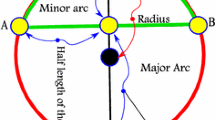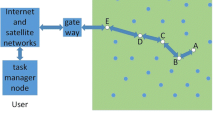Abstract
A Wireless Sensor Network (WSN) consists of many sensors that communicate wirelessly to monitor a physical region. Location information is critical essential and indispensable for many applications of WSNs. A promising solution for localizing statically deployed sensors is to benefit from mobile location-aware nodes called beacons. However, the essential problem is to find the optimum path that the mobile beacon should travel in order to improve localization accuracy, time and success as well as energy efficiency. In this paper, we evaluate the performance of five mobile beacon trajectories; Random Way Point, Scan, Hilbert, Circles and Localization algorithm with a Mobile Anchor node based on Trilateration (LMAT) based on three different localization techniques such as Weighted Centroid Localization and trilateration with time priority and accuracy priority. This evaluation aims to find effective and essential properties that the trajectory should have. Our simulations show that a random movement cannot guarantee the performance of localization. The results also show the efficiency of LMAT regarding accuracy, success and collinearity while the Hilbert space filling curve has lower energy consumption. Circles path planning can help to localize unknown sensors faster than others at the expense of lower localization precision.

















Similar content being viewed by others
References
Abolhasan, M., Wysocki, T., & Dutkiewicz, E. (2004). A review of routing protocols for mobile ad hoc networks. Ad Hoc Networks, 2, 1–22.
Akyildiz, I., Su, W., Sankarasubramaniam, Y., & Cayirci, E. (2002). Wireless sensor networks: A survey. Computer Networks, 38(4), 393–422.
Baggio, A., & Langendoen, K. (2008). Monte carlo localization for mobile wireless sensor networks. Ad Hoc Networks, 6, 718–733.
Bahi, J. M., Makhoul, A., & Mostefaoui, A. (2008a). Hilbert mobile beacon for localisation and coverage in sensor networks. International Journal of Systems Science, 39, 1081–1094.
Bahi, J. M., Makhoul, A., & Mostefaoui, A. (2008b). Localization and coverage for high density sensor networks. Computer Communications, 31, 770–781.
Bahl, P., & Padmanabhan, V. N. (2000). RADAR: An in-building RF-based user location and tracking system. In INFOCOM, IEEE, Vol. 2, pp. 775–784.
Blumenthal, J., Grossmann, R., Golatowski, F., & Timmermann, D. (2007). Weighted centroid localization in zigbee-based sensor networks. In IEEE international symposium on intelligent signal processing, WISP 2007, pp. 1–6.
Bulusu, N., Heidemann, J., & Estrin, D. (2000). Gps-less low-cost outdoor localization for very small devices. IEEE Personal Communications, 7, 28–34.
Camp, T., Boleng, J., & Davies, V. (2002). A survey of mobility models for ad hoc network research. Wireless communications and mobile computing (WCMC): special issue on mobile ad hoc networking:research, trends and applications, Vol. 2, pp. 483–502.
Chang, C. T., Chang, C. Y., & Lin, C. Y. (2012). Anchor-guiding mechanism for beacon-assisted localization in wireless sensor networks. IEEE Sensors Journal, 12, 1098–1111.
Chen, H., Shi, Q., Tan, R., Poor, H., & Sezaki, K. (2010). Mobile element assisted cooperative localization for wireless sensor networks with obstacles. IEEE Transactions on Wireless Communications, 9, 956–963.
Chipcon (2010) CC1000 low power radio transceiver. http://www.chipcon.com.
Dutkiewicz, E. (2001). Impact of transmit range on throughput performance in mobile ad hoc networks. In IEEE international conference on communications, ICC 2001, Vol. 9, pp. 2933–2937.
Galstyan, A., Krishnamachari, B., Lerman, K., & Pattem, S. (2004). Distributed online localization in sensor networks using a moving target. In ACM Ipsn, pp. 61–70.
Han, G., Choi, D., & Lim, W. (2009). Reference node placement and selection algorithm based on trilateration for indoor sensor networks. Wireless Communications and Mobile Computing, 9, 1017–1027.
Han, G., Xu, H., Duong, T., Jiang, J., & Hara, T. (2013). Localization algorithms of wireless sensor networks: A survey. Telecommunication Systems, 52, 2419–2436.
Han, G., Xu, H., Jiang, J., Shu, L., Hara, T., & Nishio, S. (2011). Path planning using a mobile anchor node based on trilateration in wireless sensor networks. Wireless Communications and Mobile Computing, 13, 1324–1336.
Han, K., Luo, J., Liu, Y., & Vasilakos, A. (2013). Algorithm design for data communications in duty-cycled wireless sensor networks: A survey. IEEE Communications Magazine, 51(7), 107–113.
Han, S., Lee, S., Lee, S., Park, J., & Park, S. (2010). Node distribution-based localization for large-scale wireless sensor networks. Wireless Networks, 16(5), 1389–1406.
He, T., Huang, C., Blum, BM., Stankovic, JA., & Abdelzaher, T. (2003). Range-free localization schemes for large scale sensor networks. In ACM MobiCom, pp. 81–95.
Hofmann-Wellenhof, B., Lichtenegger, H., & Collins, J. (1997). Global positioning system: Theory and practice. Berlin: Springer.
Hu, L., & Evans, D. (2004). Localization for mobile sensor networks. In ACM MobiCom, pp. 45–57.
Hu, Z., Gu, D., Song, Z., & Li, H. (2008). Localization in wireless sensor networks using a mobile anchor node. In Advanced intelligent mechatronics, AIM/IEEE, pp. 602–607.
Huang, R., & Zaruba, G. (2007). Static path planning for mobile beacons to localize sensor networks. In Pervasive computing and communications workshops, 2007. PerCom, pp. 323–330.
Huang, R., & Zruba, G. (2009). Monte carlo localization of wireless sensor networks with a single mobile beacon. Wireless Networks, 15(8), 978–990.
Kim, K., Jung, B., Lee, W., & Du, D. Z. (2011). Adaptive path planning for randomly deployed wireless sensor networks. Journal of Information Science and Engineering, 27, 1091–1106.
Koutsonikolas, D., Das, S. M., & Hu, Y. C. (2007). Path planning of mobile landmarks for localization in wireless sensor networks. Computter Communication, 30, 2577–2592.
Kumar, S., & Lobiyal, D. (2014). Power efficient range-free localization algorithm for wireless sensor networks. Wireless Networks, 20(4), 681–694.
Lee, S., Kim, E., Kim, C., & Kim, K. (2009). Localization with a mobile beacon based on geometric constraints in wireless sensor networks. IEEE Transactions on Wireless Communications, 8, 5801–5805.
Li, H., Wang, J., Li, X., & Ma, H. (2008). Real-time path planning of mobile anchor node in localization for wireless sensor networks. In Information and automation ICIA 2008, pp. 384–389.
Li, M., Li, Z., & Vasilakos, A. (2013). A survey on topology control in wireless sensor networks: Taxonomy, comparative study, and open issues. Proceedings of the IEEE, 101(12), 2538–2557.
Li, X., Mitton, N., Simplot-Ryl, I., & Simplot-Ryl, D. (2012). Dynamic beacon mobility scheduling for sensor localization. IEEE Transactions on Parallel and Distributed Systems, 23, 1439–1452.
Lin, J. W., & Chen, Y. T. (2008). Improving the coverage of randomized scheduling in wireless sensor networks. IEEE Transactions on Wireless Communications, 7, 4807–4812.
Mao, G., Fidan, B., & Anderson, B. D. O. (2007). wireless sensor network localization techniques. Computer Networks, 51, 2529–2553.
Moradi, M., Rezazadeh, J., & Ismail, A. S. (2012). A reverse localization scheme for underwater acoustic sensor networks. Sensors, 12, 4352–4380.
Niculescu, D., & Nath, B. (2003a). Ad hoc positioning system (aps) using aoa. In INFOCOM. IEEE, Vol. 3, pp. 1734–1743.
Niculescu, D., & Nath, B. (2003b). DV based positioning in ad hoc networks. Telecommunication Systems, 22, 267–280.
Ou, C., & He, W. (2013). Path planning algorithm for mobile anchor based localization in wireless sensor networks. Sensors Journal IEEE, 13, 466–475.
Patwari, N., Hero, A., Perkins, M., Correal, N., & O’Dea, R. (2003). Relative location estimation in wireless sensor networks. IEEE Transactions on Signal Processing, 51, 2137–2148.
Patwari, N., Ash, J., Kyperountas, S., Hero, I. A. O., Moses, R., & Correal, N. (2005). Locating the nodes: Cooperative localization in wireless sensor networks. Signal Processing Magazine IEEE, 22, 54–69.
Perrig, A., Szewczyk, R., Tygar, J., Wen, V., & Culler, D. (2002). Spins: Security protocols for sensor networks. Wireless Networks, 8(5), 521–534.
Priyantha, NB., Chakraborty, A., & Balakrishnan, H. (2000). The cricket location-support system. In ACM MobiCom, pp. 32–43.
Priyantha, NB., Balakrishnan, H., Demaine, ED., & Teller, S. (2005). Mobile-assisted localization in wireless sensor networks. In INFOCOM, IEEE, pp. 172–183.
Rappaport, T. (2001). Wireless communications: Principles and practice, 2nd edn. Prentice Hall PTR.
Rezazadeh, J., Moradi, M., & Ismail, AS. (2011) Efficient localization via middle-node cooperation in wireless sensor networks. In International conference on electrical, control and computer engineering (INECCE), 2011, pp. 410–415.
Rezazadeh, J., Moradi, M., & Ismail, A. S. (2012a). Fundamental metrics for wireless sensor networks localization. International Journal of Electrical and Computer Engineering (IJECE), 2(4), 452–455.
Rezazadeh, J., Moradi, M., & Ismail, A. S. (2012b). Message-efficient localization in mobile wireless sensor networks. Journal of Communication and Computer (JCC), 9(3), 340–344.
Rezazadeh, J., Moradi, M., & Ismail, A. S. (2012c). Mobile wireless sensor networks overview. International Journal of Computer Communications and Networks, 2(1), 17–22.
Savarese, C., & Rabaey, JM. (2001). Locationing in distributed ad-hoc wireless sensor networks. In In ICASSP, pp. 2037–2040.
Savvides, A., Han, CC., & Strivastava, MB. (2001). Dynamic fine-grained localization in ad-hoc networks of sensors. In ACM MobiCom, pp. 166–179.
Shang, Y., Ruml, W., Zhang, Y., & Fromherz, M. P. J. (2003). Localization from mere connectivity. In ACM MobiHoc, pp. 201–212.
Shee, S. H., Wang, K., & ling Hsieh Y,. (2005). Color-theory-based dynamic localization in mobile wireless sensor networks. In Proceedings of workshop on wireless (pp. 73–78). Sensor Networks: Ad Hoc.
Sheng, Z., Yang, S., Yu, Y., Vasilakos, A., McCann, J., & Leung, K. (2013). A survey on the ietf protocol suite for the internet of things: Standards, challenges, and opportunities. Wireless Communications IEEE, 20(6), 91–98.
Sichitiu, M., & Ramadurai, V. (2004). Localization of wireless sensor networks with a mobile beacon. In: IEEE international conference on mobile ad-hoc and sensor systems, MAHSS, pp. 174–183.
Ssu, K. F., Ou, C. H., & Jiau, H. (2005). Localization with mobile anchor points in wireless sensor networks. IEEE Transactions on Vehicular Technology, 54, 1187–1197.
Vasilakos, A., Zhang, Y., & Spyropoulos, T. (2012). Delay tolerant networks: Protocols and applications. Wireless networks and mobile communications. London: Taylor & Francis.
Wang, H., Qi, W., Wang, K., Liu, P., Wei, L., & Zhu, Y. (2011). Mobile-assisted localization by stitching in wireless sensor networks. In ICC, IEEE, pp. 1–5.
Wang, W., & Zhu, Q. (2009). Sequential monte carlo localization in mobile sensor networks. Wireless Networks, 15(4), 481–495.
Xiang, L., Luo, J., & Vasilakos, A. (2011). Compressed data aggregation for energy efficient wireless sensor networks. In Proceedings of the 8th annual IEEE communications society conference on sensor, mesh and ad hoc communications and networks (SECON), 2011 , pp. 46–54.
Xiao, Y., Peng, M., Gibson, J., Xie, G., Du, D. Z., & Vasilakos, A. (2012). Tight performance bounds of multihop fair access for mac protocols in wireless sensor networks and underwater sensor networks. IEEE Transactions on Mobile Computing, 11(10), 1538–1554.
Yao, Y., Cao, Q., & Vasilakos, A. (2014). Edal: An energy-efficient, delay-aware, and lifetime-balancing data collection protocol for heterogeneous wireless sensor networks. In IEEE/ACM transactions on networking, Vol. 99, pp. 1–1.
Zamalloa, MZn., & Krishnamachari, B. (2007). An analysis of unreliability and asymmetry in low-power wireless links. ACM Transactions on Sensor Networks, 3, 1–34.
Zeng, Y., Xiang, K., Li, D., & Vasilakos, A. (2013). Directional routing and scheduling for green vehicular delay tolerant networks. Wireless Networks (10220038), 19(2), 161–173.
Author information
Authors and Affiliations
Corresponding author
Rights and permissions
About this article
Cite this article
Rezazadeh, J., Moradi, M., Ismail, A.S. et al. Impact of static trajectories on localization in wireless sensor networks. Wireless Netw 21, 809–827 (2015). https://doi.org/10.1007/s11276-014-0821-z
Published:
Issue Date:
DOI: https://doi.org/10.1007/s11276-014-0821-z




